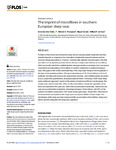The imprint of microfibres in southern European deep seas
| dc.contributor.author | Sanchez-Vidal, A | |
| dc.contributor.author | Thompson, Richard | |
| dc.contributor.author | Canals, M | |
| dc.contributor.author | de Haan, WP | |
| dc.date.accessioned | 2018-12-21T14:40:13Z | |
| dc.date.issued | 2018-11-05 | |
| dc.identifier.issn | 1932-6203 | |
| dc.identifier.issn | 1932-6203 | |
| dc.identifier.other | ARTN e0207033 | |
| dc.identifier.uri | http://hdl.handle.net/10026.1/13099 | |
| dc.description | No embargo required. | |
| dc.description.abstract |
Pollution of the marine environment by large and microscopic plastic fragments and their potential impacts on organisms has stimulated considerable research interest and has received widespread publicity. However, relatively little attention has been paid to the fate and effects of microplastic particles that are fibrous in shape, also referred as microfibres, which are mostly shed from synthetic textiles during production or washing. Here we assess composition and abundance of microfibres in seafloor sediments in southern European seas, filling gaps in the limited understanding of the long-range transport and magnitude of this type of microplastic pollution. We report abundances of 10-70 microfibres in 50 ml of sediment, including both natural and regenerated cellulose, and synthetic plastic (polyester, acrylic, polyamide, polyethylene, and polypropylene) fibres. Following a shelf-slope-deep basin continuum approach, based on the relative abundance of fibres it would appear that coastal seas retain around 33% of the sea floor microfibres, but greater quantities of the fibres are exported to the open sea, where they accumulate in sediments. Submarine canyons act as preferential conduits for downslope transport of microfibres, with 29% of the seafloor microfibres compared to 18% found on the open slope. Around 20% of the microfibres found had accumulated in the deep open sea beyond 2000m of water depth. The remoteness of the deep sea does not prevent the accumulation of microfibres, being available to become integrated into deep sea organisms. | |
| dc.format.extent | e0207033-e0207033 | |
| dc.format.medium | Electronic-eCollection | |
| dc.language | en | |
| dc.language.iso | en | |
| dc.publisher | Public Library of Science | |
| dc.subject | Cellulose | |
| dc.subject | Europe | |
| dc.subject | Geologic Sediments | |
| dc.subject | Oceans and Seas | |
| dc.subject | Plastics | |
| dc.subject | Polymers | |
| dc.subject | Water Pollutants, Chemical | |
| dc.title | The imprint of microfibres in southern European deep seas | |
| dc.type | journal-article | |
| dc.type | Journal Article | |
| dc.type | Research Support, Non-U.S. Gov't | |
| plymouth.author-url | http://gateway.webofknowledge.com/gateway/Gateway.cgi?GWVersion=2&SrcApp=PARTNER_APP&SrcAuth=LinksAMR&KeyUT=WOS:000449291400076&DestLinkType=FullRecord&DestApp=ALL_WOS&UsrCustomerID=11bb513d99f797142bcfeffcc58ea008 | |
| plymouth.issue | 11 | |
| plymouth.volume | 13 | |
| plymouth.publication-status | Published online | |
| plymouth.journal | PLoS ONE | |
| dc.identifier.doi | 10.1371/journal.pone.0207033 | |
| plymouth.organisational-group | /Plymouth | |
| plymouth.organisational-group | /Plymouth/Faculty of Science and Engineering | |
| plymouth.organisational-group | /Plymouth/Faculty of Science and Engineering/School of Biological and Marine Sciences | |
| plymouth.organisational-group | /Plymouth/REF 2021 Researchers by UoA | |
| plymouth.organisational-group | /Plymouth/REF 2021 Researchers by UoA/UoA07 Earth Systems and Environmental Sciences | |
| plymouth.organisational-group | /Plymouth/Research Groups | |
| plymouth.organisational-group | /Plymouth/Research Groups/Marine Institute | |
| plymouth.organisational-group | /Plymouth/Users by role | |
| plymouth.organisational-group | /Plymouth/Users by role/Academics | |
| plymouth.organisational-group | /Plymouth/Users by role/Researchers in ResearchFish submission | |
| dc.publisher.place | United States | |
| dcterms.dateAccepted | 2018-10-23 | |
| dc.rights.embargodate | 2019-11-27 | |
| dc.identifier.eissn | 1932-6203 | |
| dc.rights.embargoperiod | Not known | |
| rioxxterms.versionofrecord | 10.1371/journal.pone.0207033 | |
| rioxxterms.licenseref.uri | http://www.rioxx.net/licenses/all-rights-reserved | |
| rioxxterms.licenseref.startdate | 2018-11-05 | |
| rioxxterms.type | Journal Article/Review |


